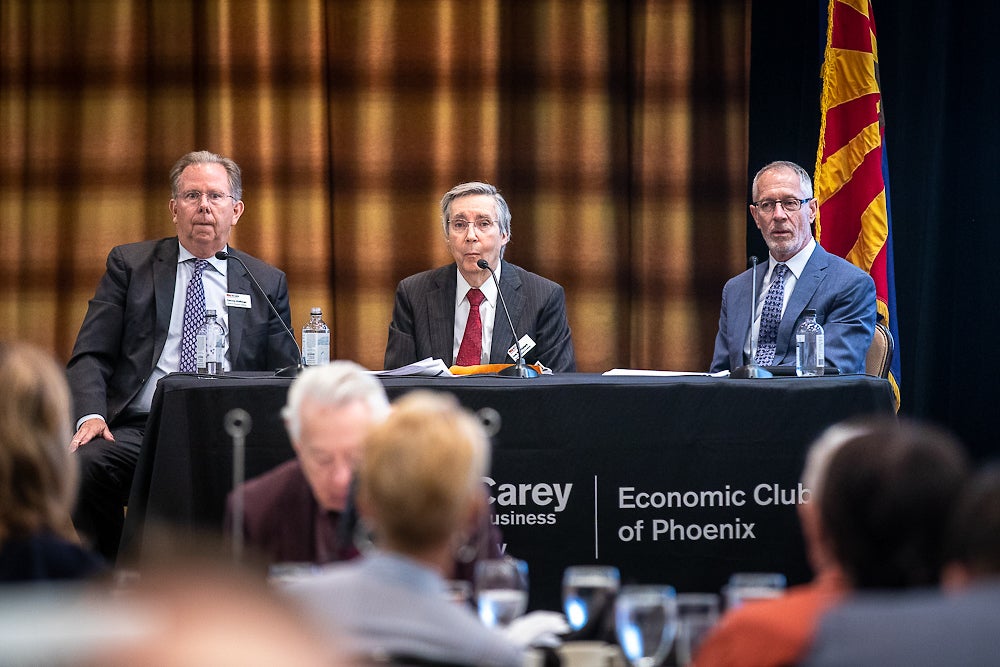Arizona’s economy is thriving and is likely to flourish at least for another year, according to economics experts at Arizona State University.
“We’re coming off a super-strong year, and it’s giving us a lot of momentum,” said Lee McPheters, research professor of economics in the W. P. Carey School of Business at ASU and director of the school’s JPMorgan Chase Economic Outlook Center. He spoke at the annual economic forecast luncheon held by the Economic Club of Phoenix, a unit of W. P. Carey.
McPheters said that 2018 surprised even analysts like him. He predicted that 69,000 new jobs would be added in Arizona for the year, when in fact, 78,800 jobs were added. Arizona was fourth in the nation for job creation.
“We’re continuing to get the benefit of more people moving here and a relatively robust birth rate and that’s a key driver for the economy,” he said, noting that Arizona is also fourth in the nation for population growth. “There is no recession in sight for our forecast.”
The job growth is mostly in construction, followed by health care, professional/scientific, manufacturing and transportation.
McPheters said that people remember the recession of 2008, when the vigorous housing market collapsed.
“Are we on the verge of a bubble? Well, as a percent of all jobs, construction is about 5.7%, not the 9 or 10% it was in 2006,” he said.
Also, the additional construction jobs are supporting job growth.
“It’s construction of office space, distribution space and public-sector investment.”
McPheters sounded an alarm about affordable housing. He said that wages have gone up 12% while home prices have increased 31%.
“That is putting a squeeze on people,” he said.
(From left) Dennis Hoffman, Lee McPheters and Mark Stapp answer questions at the Economic Club of Phoenix's annual economic outlook luncheon on Thursday. The three offered views ranging from national trends to local factors in their consensus view that the Arizona will continue growing, but will slow down a little in the coming year. Photo by Charlie Leight/ASU Now
McPheters said the biggest threat to Arizona’s economy is the national economy. On that front, Dennis Hoffman was optimistic.
“We’re in a strong employment expansion that has been unrelenting since 2014 and should continue for the foreseeable future,” said Hoffman, an economist and the director of the L. William Seidman Research Institute at the W. P. Carey School of Business.
“What’s fueling the economy? Less regulation is behind some of it,” he said. “People argue about regulation and the long-term consequences, but I think it sustained the growth in 2017 and 2018.”
Hoffman discussed several potential problems ahead.
“People worry about global warming, but I worry about global graying,” he said. “For the first time ever, we have more people 65 and older than 5 and younger.
“That will change the way people consume, what they’ll buy and how much they spend.”
He’s also worried about the increasing national debt.
“What’s driving it is mandatory entitlements. Nobody wants to hear this, but we simply do not have enough in receipts to pay for the Medicare that Baby Boomers expect.”
The commercial real estate market also is booming as workers are filling up all the new space, according to Mark Stapp, the Fred E. Taylor Professor in Real Estate in the W. P. Carey School of Business.
“Whatever we’re building, we’re absorbing,” he said. “I don’t think we’ll run the risk of oversupply. If we want to see job growth, we have to have space for those jobs to go.”
One interesting trend has been a change in the use of retail space. More than 6,000 stores have closed nationwide this year, while only 2,600 have opened.
“But now we’re seeing other kinds of users,” he said. “Eighteen percent of medical offices now occupy retail space. This is a shift to put them closer to where people need them.”
Stapp echoed McPheters’ concerns about affordable housing.
“We are building what we need to house the population that is moving here and not building in excess, and that continues to push prices up,” he said. “There’s no slack in the inventory.”
Stapp said that new housing is gobbling up 6,000 acres a year in the Valley.
“Where do you get those 6,000 acres? We are pushing toward the edges again — Coolidge, Florence, Queen Creek, Casa Grande, Buckeye.”
Stapp said that one positive effect of the recession, when 10 million people nationwide lost their homes, has been the de-stigmatization of renting. One new trend he expects to grow is the construction of single-family rental communities.
“It solves the problem of ‘I don’t want to buy. I can’t afford it. But I still want a single-family home.’”
Top photo: JP Morgan Chase Economic Outlook Director Lee McPheters speaks at the Economic Club of Phoenix's annual economic outlook luncheon at the Scottsdale Resort at McCormick Ranch on Thursday. Photo by Charlie Leight/ASU Now
More Law, journalism and politics

ASU Law to honor Africa’s first elected female head of state with 2025 O’Connor Justice Prize
Nobel Peace Prize laureate Ellen Johnson Sirleaf, the first democratically elected female head of state in Africa, has been named the 10th recipient of the O’Connor Justice Prize.The award,…

Native Vote works to ensure the right to vote for Arizona's Native Americans
The Navajo Nation is in a remote area of northeastern Arizona, far away from the hustle of urban life. The 27,400-acre reservation is home to the Canyon de Chelly National Monument and…

New report documents Latinos’ critical roles in AI
According to a new report that traces the important role Latinos are playing in the growth of artificial intelligence technology across the country, Latinos are early adopters of AI.The 2024 Latino…

